The scenes following the death of Queen Elizabeth II – crowds lining the streets from Balmoral to Windsor, a days-long queue to the Palace of Westminster, floral tributes outside Buckingham Palace – showcased public displays of mourning not seen since the death of Diana, Princess of Wales in 1997. The widespread scale of grief and commemoration witnessed during these events might seem like a modern phenomenon, but they bear an uncanny resemblance to events from 205 years ago, following the untimely death of another Princess of Wales, Charlotte Augusta, in 1817. Young and full of promise, Charlotte’s death generated an overwhelming demand for memorial souvenirs which were eagerly collected by the British public to mourn her. These commemorative objects gained such popularity and helped to establish a unique tradition of remembrance that continues today.
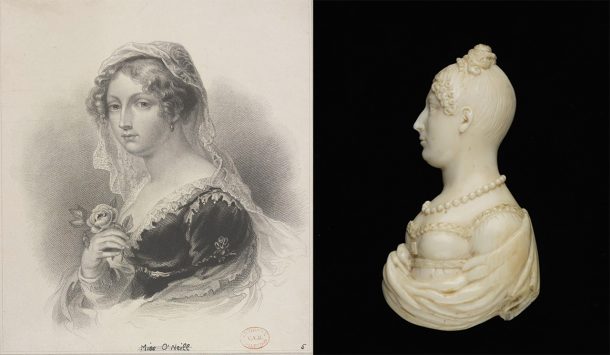
Born on January 7, 1796, Charlotte was the only child of George, Prince of Wales (later King George IV) and Caroline of Brunswick, and the granddaughter of King George III. While her grandfather was exceedingly unpopular, Charlotte was seen by many as a breath of fresh air and ‘the Hope of Britain’, representing an opportunity to restore and reenergize the monarchy. The public delighted in sharing in the details of her life, especially the pageantry surrounding her royal wedding to Leopold of Saxe-Coburg in January 1816. Her sudden and tragic death came when she was just 21 years old, following complications in childbirth (her baby was also stillborn), sending shockwaves through Britain, and triggering dramatic expressions of grief and sympathy. Henry Brougham, a statesman who later became Lord High Chancellor, wrote at the time that “[i]t really was as though every household throughout Great Britain had lost a favourite child”. A stream of sermons, essays and poems were published and recited by leading figures of the day in the Princess’s honour.
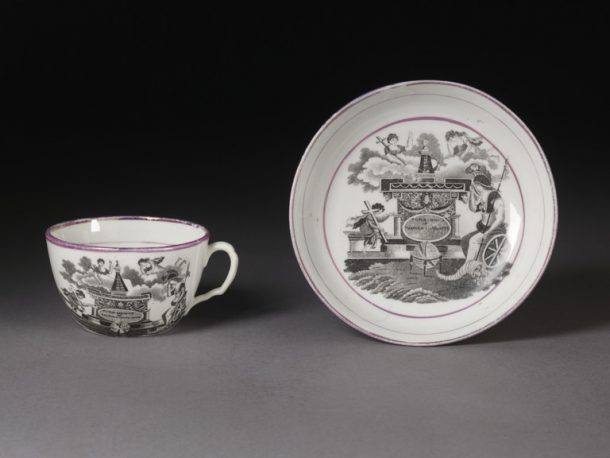
Before Charlotte’s death, people traditionally marked official periods of mourning by wearing black armbands. However, the Princess’ immense popularity encouraged so many people to don mourning clothes that linen-drapers reportedly ran out of black cloth. An overwhelming demand for physical memorabilia emerged seemingly overnight as people looked for new and fashionable ways to memorialize Charlotte’s all-too-brief life. These memorial tokens ranged from tea sets to medals, spanning prints, sculpture, ceramics, textiles and jewellery. Many mementoes, like this porcelain cup and saucer and design for a commemorative tile, are decorated with the figure of Britannia (symbolising Great Britain) mourning at a tomb carrying the inscription ‘to the Memory of Princess Charlotte.’
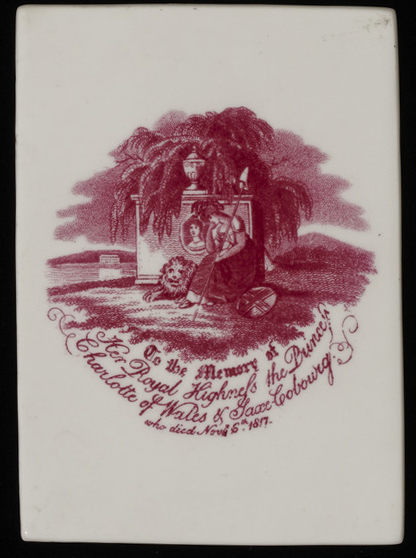
A plate-printed cotton panel, most likely intended to be framed and hung as a picture, shows a full-length portrait of Charlotte, who was known to favour an unpretentious style of dress. On the left side, a faint image of the flag raised above Windsor Castle can be seen waving in the distance as a reference to St George’s Chapel, where the Princess and her son were buried.
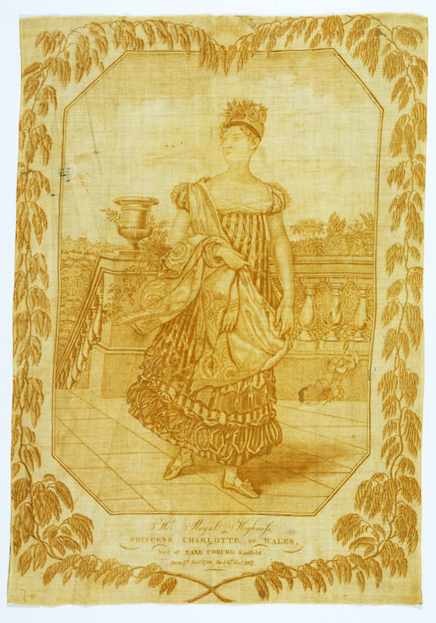
Charlotte’s likeness was also reproduced in various wax portraits, which were very popular in the 19th century due to their affordability and portable size. In a portrait made by acclaimed English wax modeller Peter Rouw, Charlotte appears with a wreath of roses around her hair, one of her trademark fashions. A version of the portrait – also in wax – was later exhibited at the Royal Academy in 1818, alongside 12 other artworks that were inspired by the late Princess. A more subdued wax portrait of Charlotte is set in a wooden mount shaped like a pocket-sized memorial stone. An inscription near the top reads, “To the Memory of Charlotte Augusta, On 6 Nov 1817, Aged 21”, while a printed description of the funeral procession covers the back.

Tributes were also crafted as more personal and luxurious keepsakes, like this gold pendant, set with a miniature portrait and decorated with enamel, rock crystal and diamonds. The portrait was made by Charlotte Jones, who served as miniature painter to the Princess. Stored in an urn dangling below the portrait, three locks of Charlotte’s hair are curled into the shape of feathers (the symbol of the Prince of Wales). The inclusion of Charlotte’s hair suggests that the pendant was made for someone who was very close to her.
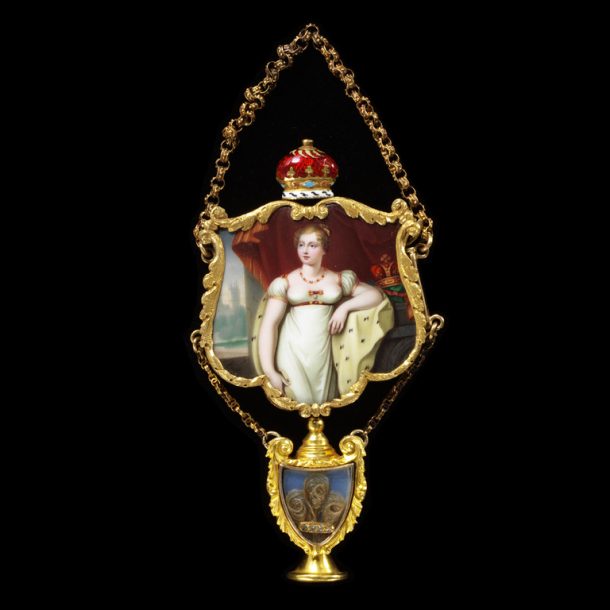
The period of mourning for Charlotte Augusta would later be described in the 1840s by social theorist Harriet Martineau as an unprecedented one: “never was a whole nation plunged in such deep and universal grief. From the highest to the lowest, this death was felt as a calamity that demanded the intense sorrow of domestic misfortune”. The extensive production and sale of souvenirs played a crucial role in making this experience of grief available to people from all social classes. Charlotte was seen by many as a ‘princess of the people’ during her life, a bond that became strengthened with the purchase of every commemorative tile and teacup following her death.
See more commemorative objects inspired by Princess Charlotte in our collection.



Such an interesting article. Fascinating to see the souvenirs and mementos that were popular over 200 years ago.